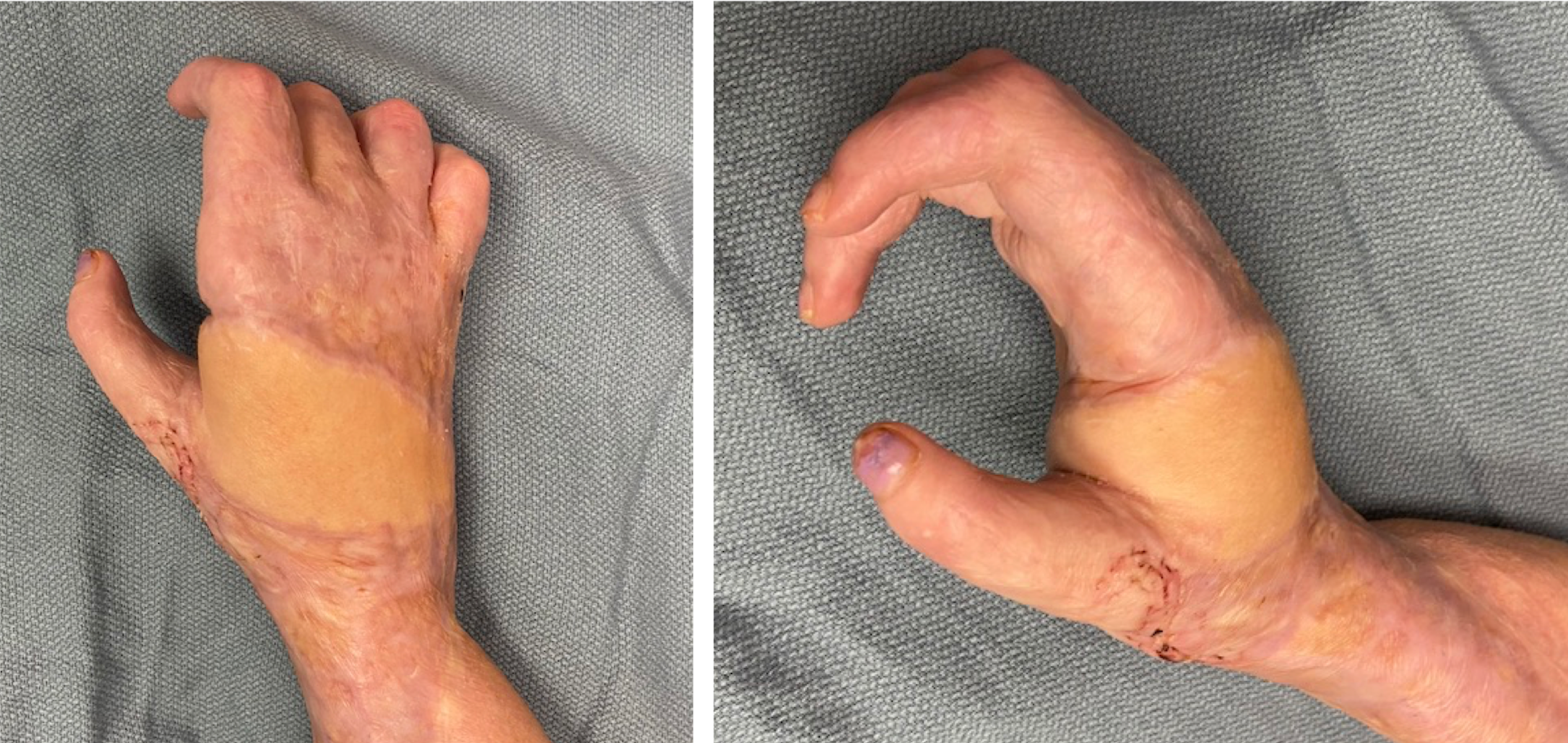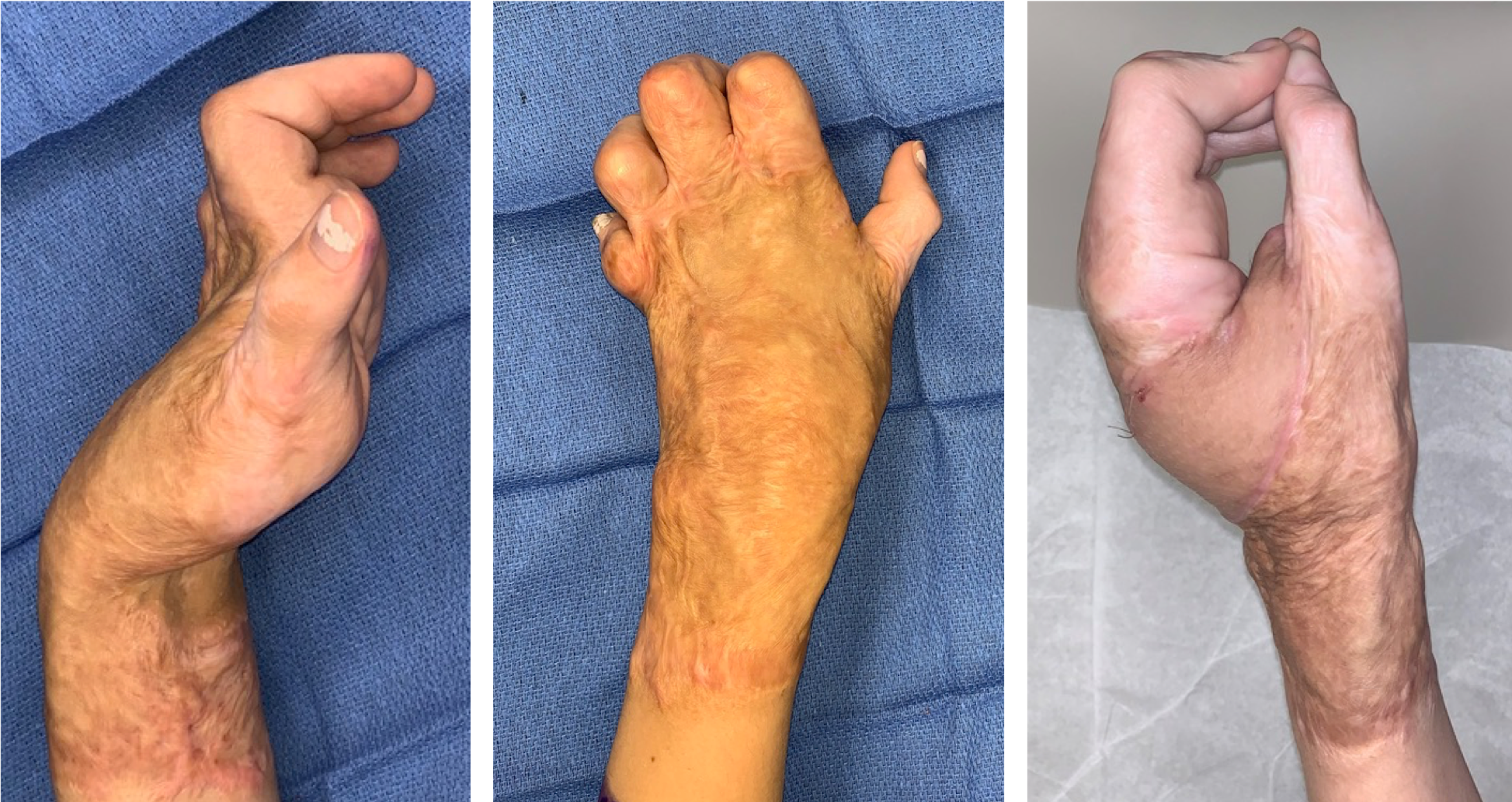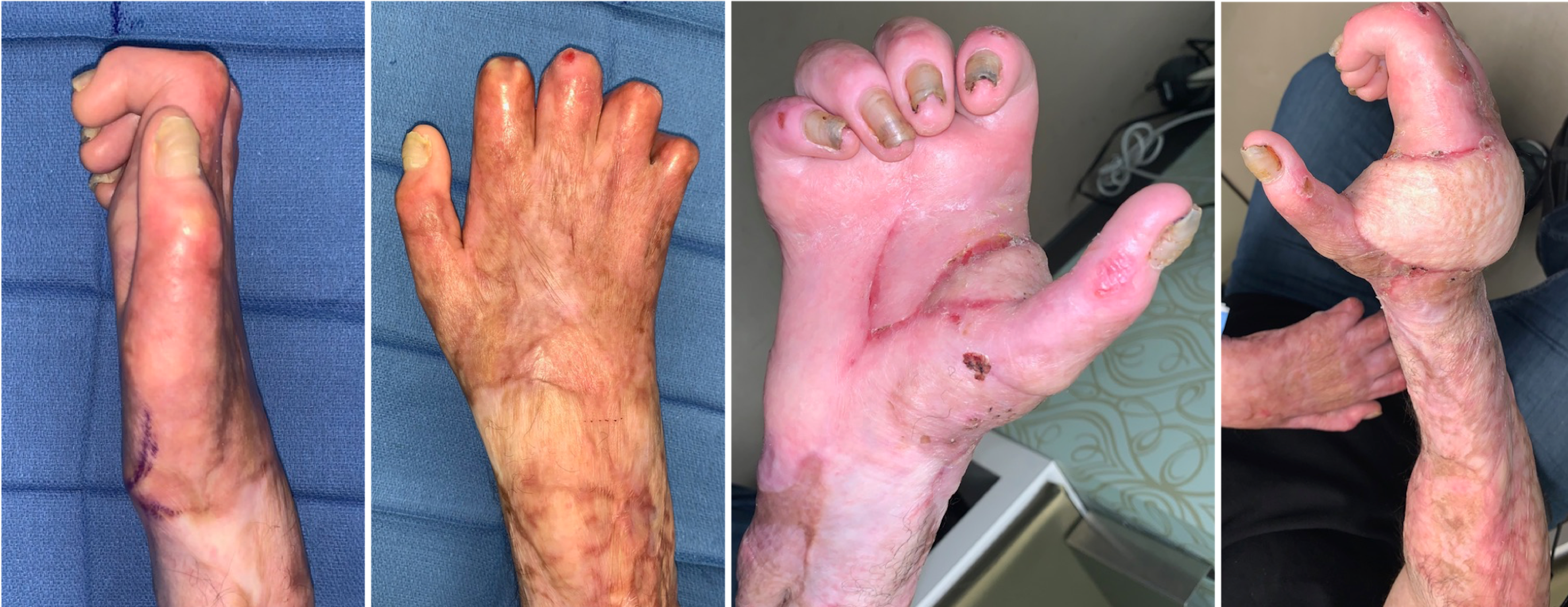ADVERTISEMENT
Pedicled Groin Flap for Reconstruction of Combined First Webspace and Dorsal Hand Contracture
Abstract
Background. The combination of first webspace and dorsal hand contracture is a challenging reconstructive problem. Complete soft tissue release results in a large wraparound defect that spans the radial side of the palm, first webspace, and the transverse dimension of the entire dorsal hand. In these situations local tissue is often compromised, and free flap reconstruction is commonly indicated. However, in cases where patients are unwilling or unable to undergo microsurgical reconstruction, regional tissue transfer provides an alternative reconstructive strategy. This case report describes a series of 3 patients with severe combined contractures of the first webspace and dorsal hand. Each patient was relatively contraindicated for local or free tissue transfer and was treated with 2-stage selective contracture release with progressive dorsal then volar defect creation and coverage using a pedicled groin flap. This operation requires thoughtful planning during soft tissue release to coordinate staged, dorsal then volar, defect creation with the progressive liberation of the groin flap at its distal and then proximal ends.
Introduction
An ample first webspace is critical for thumb abduction and opposition, grasping, pinching, and prehension.1 Mobility of the thumb accounts for 40 to 50% of hand function, and as such, web space contracture results in a significant disability.2,3 Contracture of the first web space may occur secondary to congenital malformation, burns, trauma, inappropriate immobilization/splinting, arthritis, infection, ischemia, paralysis, or spastic conditions and may affect the skin, intrinsic muscles, tendons, and first carpometacarpal (CMC) joint.1,4-6 Prevention of contracture is paramount, and many splinting techniques have been described.5
Dorsal hand contracture often accompanies first webspace contracture and is a cause of substantial functional limitation.7 Fixed metacarpophalangeal (MCP) hyperextension causes relative extrinsic tightness leading to interphalangeal joint flexion. When this exaggerated claw posture is combined with a first webspace contracture, the hand lacks any prehension and serves as little more than a helper “paddle” for bimanual tasks.

The combination of first webspace and dorsal hand contracture is a challenging reconstructive problem (Figure 1) because complete soft tissue release results in a large defect that spans the radial side of the palm, first webspace, and the transverse dimension of the entire dorsal hand obliquely. These “wraparound” defects can expose all of the digital extensor tendons and extend deep into the first webspace towards the trapziometacarpal joint. Reconstruction usually requires transfer of a substantial amount of full-thickness vascularized soft tissue.
This case report describes a series of 3 patients with severe combined contractures of the first webspace and dorsal hand. Each patient was relatively contraindicated for local or free tissue transfer and was treated with selective 2-stage contracture release with progressive dorsal then volar defect coverage using a pedicled groin flap.
Methods
First-Stage Operation

This procedure is performed under general anesthesia with tourniquet control of the upper extremity. The patient is positioned supine with the operative hand extended on a hand table and a bump placed under the ipsilateral hip. The sterile field of the upper extremity and ipsilateral groin should be continuous and unimpeded.
An incision of the contracted first webspace and dorsal hand is marked in a single curve extending from the radial side of the palm within the proximal palmar crease through the webspace and transversely across the dorsal hand (Figure 2). Importantly, at the first operation only the dorsal portion of this incision is made, and the contracted volar skin is left intact. This is done to avoid creation of a volar wound prior to liberation of the proximal portion of the groin flap that will eventually fill this defect.

In cases of chronic contracture or neuromuscular dysfunction, the first dorsal interosseous and abductor pollicis muscles often require release from the thumb ray (Figure 3). The thumb may be provisionally pinned (from the first to second metacarpal) in radial abduction (Figure 4) to maintain the release between surgical stages but should not be pinned in a position of true opposition (which is ultimately desired) because this will restrict apposition of the hand to the groin during flap inset. Contracture of the index through small finger MCP joints is expected, and open capsulectomy (though separate longitudinal incisions) with temporary antegrade transarticular pinning is performed to restore a position of 30 to 40° of MCP joint flexion (Figure 4).

Doppler is used to mark the axis of the superficial circumflex inferior artery (SCIA). The web space defect is templated onto the donor site, centered upon the SCIA axis (Figure 5). The flap should be extended as superolateral as possible (based upon the vascular limitations noted above) to ensure adequate flap length and ease of inset. Elevation proceeds from lateral to medial in the suprafascial plane. When the sartorius is encountered, the fascia is divided laterally, taking care to preserve the deep branch of the SCIA. Care should also be taken to protect the lateral femoral cutaneous nerve that courses under the inguinal ligament and along the septum between the tensor fascia lata and the sartorius. When the medial border of the sartorius is identified, dissection stops to protect the SCIA origin.

The flap is tubularized proximally to protect the pedicle (Figure 5), and the hand is brought to the groin. The distal aspect of the tubularized portion is inset to the volar extent of the incision in the first webspace, and then the distal flap is inset into the dorsal hand. This leaves the flap traversing the partially released first webspace and initially resurfacing only the dorsal hand (Figure 6). The donor site is closed in layers, and a drain may be placed at the surgeon’s discretion.

The incisions are dressed with antibiotic ointment and xeroform, and the hand is covered with abdominal pads. An abdominal binder is placed around the operative extremity to ensure it remains in a good position without any tension on the groin flap. The operative extremity remains immobilized until division and inset at a second stage.
Second-Stage Operation
After approximately 3 weeks, the patient returns to the operating room for division, completion of first web space release, and flap inset. The patient is positioned supine, and a hand table is included in the field to accommodate the flap after division. A Penrose drain is used to occlude the base of the groin flap, and flap perfusion is evaluated (Figure 7). If there is concern for vascular compromise with the Penrose in place, division should be further delayed.

The flap is divided from the groin at its base, leaving all of the flap with the hand. The base of the flap is detubularized and granulation tissue excised. The proximal portion of the groin flap will be used to fill the volar first webspace defect (Figure 8).


The intermetacarpal pins maintaining thumb position are removed, and the skin contracture release is extended from its previous termination at the first web down into the palm via proximal palmar crease (Figure 9). As release of all contracted dorsal skin, muscle, and joint capsule was performed at the first stage, this should yield a freely mobile thumb. The thumb is re-pinned in its final position of opposition. This position is chosen with the patient’s expected active mobility in mind, considering the dual goals of achieving active pinch and an ample first webspace. The groin flap is inset through the webspace (Figure 10), and the remaining groin donor site is freshened and closed.

The hand is splinted in the immediate postoperative period but can be transitioned to a removable hand-based thumb spica orthosis at the first postoperative visit. The intermetacarpal and trans-MCP wires maintaining the thumb position and index through small finger MCP flexion, respectively, are removed 4 weeks after the second operation. Splinting is weaned over the following month, but ongoing nighttime splinting is advisable.
Results
Case 1
A 14-year-old female presented with right first web space and dorsal hand contracture related to an episode of severe sepsis and purpura fulminans with extensive skin and muscle necrosis. The thumb was in a position of fixed adduction against the index ray, and the dorsal hand contracture had resulted in fixed MCP hyperextension with interphalangeal joint flexion (Figure 1). Reverse radial forearm and posterior interosseous artery donor sites were unavailable given a history of diffuse skin necrosis and multiple prior right upper extremity reconstructive surgeries. Given her strong desire to avoid inpatient hospitalization, the patient was not amenable to free tissue transfer, and a staged release with groin flap reconstruction was planned. She underwent first-stage dorsal skin contracture release with division of the contracted and fibrotic adductor pollicis longus and the first dorsal interosseous muscles, and the first metacarpal was maintained in a position of radial abduction using K-wires. Index through small finger MCP-joint capsulotomies were performed, and each of these joints was pinned in 30 to 40° of flexion. An ipsilateral groin flap was used to cover the dorsal hand and first webspace defect. During the same operation, extensor tendon lengthening in the forearm was performed. The groin flap was divided and the volar skin of the first webspace was released 3 weeks later. After revising the first metacarpal pinning construct to optimally position the thumb after complete release, the proximal portion of the groin flap was detubularized and used to fill the volar skin defect. All pins were removed 7 weeks after the index operation.

In the first several months after surgery, the thumb position was optimal and the webspace was ample. However, at 7 months postoperatively, the patient had recurrence of her thumb adduction contracture, likely due to constantly resting this thumb on the arm of her wheelchair. First webspace soft tissues were ample, and she was treated with thumb repositioning and first carpometacarpal joint arthrodesis without soft tissue revision. The final result is shown in Figure 11.
Case 2

A 15-year-old female presented with left hand first webspace and dorsal hand contracture resultant from 50% total body surface area (TBSA) burns sustained in a house fire. Prior skin graft and z-plasty procedures had been unsuccessful, and the hand was entirely without prehension. The patient underwent the staged procedures described; however, complete division of the adductor pollicus and first dorsal interosseous muscles was not required. At 3 months from the index operation, there was an ample first webspace and the dorsal hand contracture had been fully corrected (Figure 12). The patient recovered thumb mobility and dexterity to the point that she could text message with ease (Video 1).
Case 3

A 30-year-old male presented with right hand first webspace and dorsal hand contracture resultant from 95% TBSA burns sustained in a house fire. Given the extent of his burns, donor sites were extremely limited. The patient underwent the staged procedures described above. At 3 months from the index operation, there was an ample first webspace and the dorsal hand contracture had been fully corrected (Figure 13). The groin flap is excessively thick, and the patient will benefit from flap debulking in the future.
Discussion
Release of contracted tissues in the first webspace and on the dorsal hand results in a large “wraparound” defect that may span from the mid-palm to the dorsal wrist crease. Coverage of this defect with vascularized soft tissue is important not only for coverage of tendon and joint but also to facilitate digital and thumb mobility and to avoid recurrent contracture. Free tissue transfer is generally the reconstructive technique of choice to release and completely resurface the hand in these situations. However, situations arise wherein free tissue transfer is not practical or possible. The most common reasons for this situation are limited donor sites, limited recipient-site vessels, free flap failure, and/or patient unwillingness or unsuitability for free tissue transfer.
Whereas reverse radial forearm or posterior interosseous flaps could theoretically be suitable for some cases, many patients who require this type of reconstruction have extensive scarring throughout potential donor sites on the contracted limb, and the microvasculature at these flap donor sites may be abnormal. In situations where both free and local pedicle flaps are unsuitable, these cases have made use of the distant pedicled groin flap.
Though coverage of a soft tissue–deficient groin flap is not a new idea, there are several nuances of this technique as it applies to the unique problem of combined dorsal hand and first webspace contracture. The most important of these is a thoughtful staged release of the contracture. As detailed above, this should begin dorsally, without incision of the palmar skin at the first stage. Conducting the operation in this manner avoids the problems associated with leaving a large open palmar wound at the groin for several weeks. Furthermore, because the release is not completed at the first operation, the thumb cannot and should not be pinned into its final opposed position until the second stage. Rather, it is pinned provisionally in a position of radial abduction, which facilitates dorsal flap inset and keeps it out of the way while positioning the hand at the groin. Final positioning of the thumb in an ideal opposed position occurs only at the second operation after volar soft tissue release and final inset of the trailing edge of the flap.
After this staged soft tissue release, an optimal result is defined by a resting position of the thumb in approximately 45° of palmar abduction and 100 to 120° of pronation, with the MCP joints in a resting position of 20 to 40° of flexion (increasing from radial to ulnar). The webspace is wide enough to admit a large dowel (like a beverage, cane, or railing) but not so wide that index-thumb pinch is inaccessible.
In situations of limited contracture chronicity where adductor pollicus and first dorsal interosseous muscles did not require complete transection, normal thumb CMC joint mobility and pinch function may be restored (Case 2). In situations where complete muscle transection is required, thumb mobility is compromised in favor of optimal positioning at rest (Case 1). Especially in cases where limited active mobility is anticipated, the thumb position must be chosen carefully at the second operation considering both the breadth of the webspace and the capacity for thumb-index pinch.
Due to the necessity for immobilization of the injured extremity for 3 weeks while attached to the ipsilateral groin, stiffness in the joints of this extremity may occur. As such, caution should be exercised when considering this flap for an elderly patient.8 Furthermore, whereas this flap does not generally require inpatient admission (which may be among the reasons that some patients decline free tissue transfer), it does require a prolonged period of decreased activity and patient cooperation. Patients with substance abuse, mental health, or behavioral problems may not be suitable candidates. This technique is relatively contraindicated in patients with prior history of trauma or surgery to the ipsilateral groin, as this suggests the vascular supply may be interrupted.8
The most common complication of the pedicled groin flap is stiffness of upper extremity joints due to the required immobilization while the flap remains pedicled.8 Frozen shoulder is described as an aggravating consequence, with increased risk with increasing age.11,12 However, even in the elderly, groin flaps remain a feasible option with early physiotherapy to decrease the risk of associated joint stiffness.13 As demonstrated in Case 1, first webspace contracture can recur at the CMC joint level even after ample soft tissue resurfacing. In this case, constant positioning of the thumb against a wheelchair armrest pushed the thumb back into adduction. Because the soft tissues remained ample, this complication was resolved with first CMC joint arthrodesis in the desired position.
Acknowledgments
Affiliations: 1Division of Plastic and Reconstructive Surgery, Department of Surgery, School of Medicine, Washington University, St. Louis, MO; 2Section of Plastic and Reconstructive Surgery, Department of Surgery, School of Medicine, Louisiana State University, New Orleans, LA
Correspondence: Mitchell A. Pet, MD; mpet@wustl.edu
Disclosures: The authors have nothing to disclose, including no conflicts of interest and no source of funding.
References
1. Jensen CB, Rayan GM, Davidson R. First web space contracture and hand function. J Hand Surg Am. 1993;18(3):516-520. doi:10.1016/0363-5023(93)90103-A
2. Flatt AE. Our thumbs. Proc (Bayl Univ Med Cent). 2002;15(4):380-387. doi:10.1080/08998280.2002.11927870
3. Therattil PJ, Datiashvili RO. First web space contracture. Eplasty. 2014;14:ic28. Published 2014 Aug 21.
4. Gong X, Lu LJ. Reconstruction of severe contracture of the first web space using the reverse posterior interosseous artery flap. J Trauma. 2011;71(6):1745-1749. doi:10.1097/TA.0b013e3182325e27
5. Masden DL, Higgins JP. Predictors of successful outcomes in first web space contracture release. Hand (N Y). 2011;6(1):50-55. doi:10.1007/s11552-010-9294-4
6. Moody L, Galvez MG, Chang J. Reconstruction of first web space contractures. J Hand Surg Am. 2015;40(9):1892-1896. doi:10.1016/j.jhsa.2015.06.113
7. Cauley RP, Helliwell LA, Donelan MB, Eberlin KR. Reconstruction of the adult and pediatric burned hand. Hand Clin. 2017;33(2):333-345. doi:10.1016/j.hcl.2016.12.006
8. Yang G, Chung KC. Pedicled and free groin flap. In: Operative Techniques: Hand and Wrist Surgery E-Book. 3rd ed. Elsevier Health Sciences; 2016:695-702.
11. Graf P, Biemer E. Morbidity of the groin flap transfer: are we getting something for nothing?. Br J Plast Surg. 1992;45(2):86-88. doi:10.1016/0007-1226(92)90162-q
12. Amouzou KS, Berny N, El Harti A, Diouri M, Chlihi A, Ezzoubi M. The pedicled groin flap in resurfacing hand burn scar release and other injuries: a five-case series report and review of the literature. Ann Burns Fire Disasters. 2017;30(1):57-61.
13. Buchman SJ, Eglseder WA Jr, Robertson BC. Pedicled groin flaps for upper-extremity reconstruction in the elderly: a report of 4 cases. Arch Phys Med Rehabil. 2002;83(6):850-854. doi:10.1053/apmr.2002.32491















